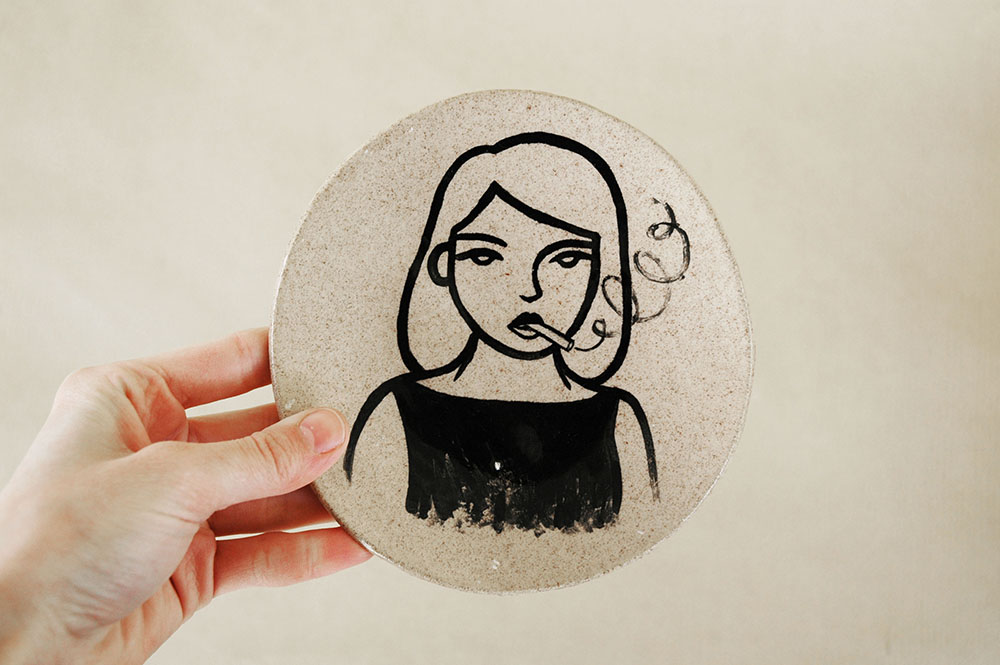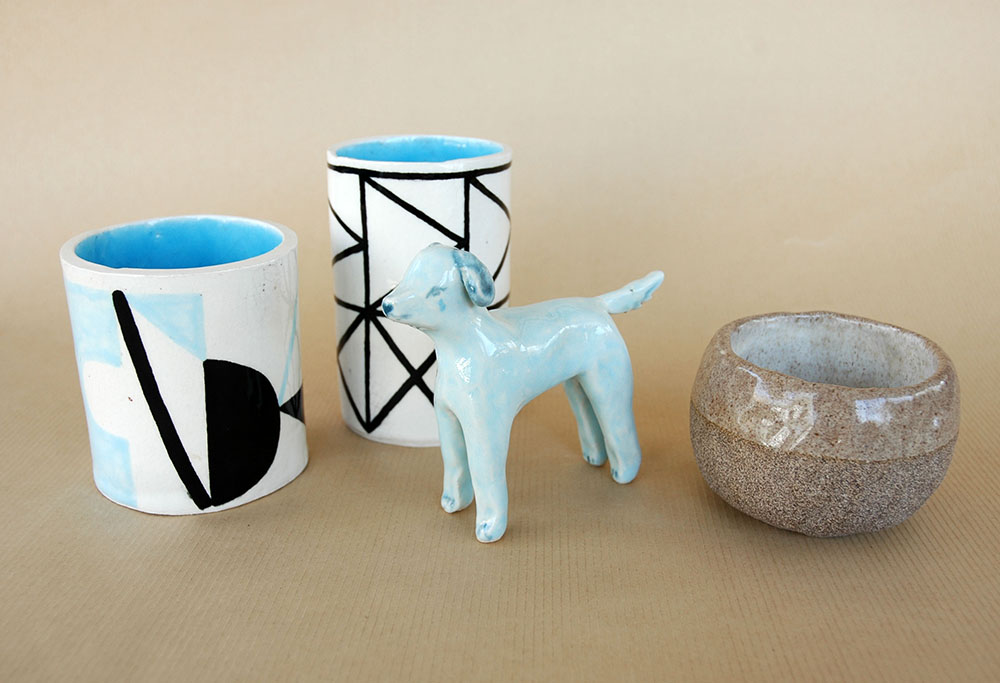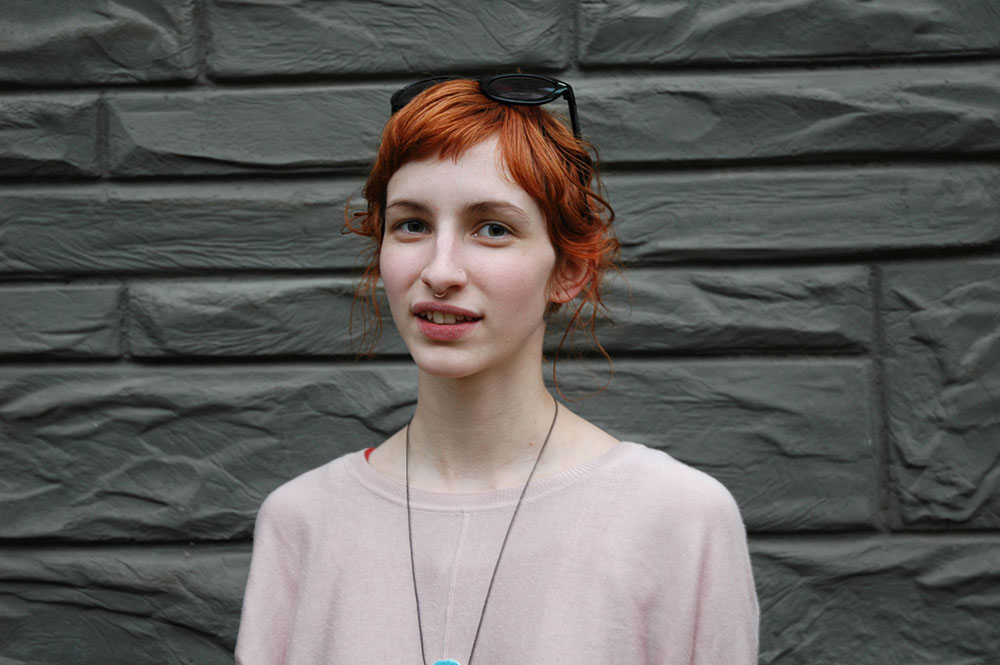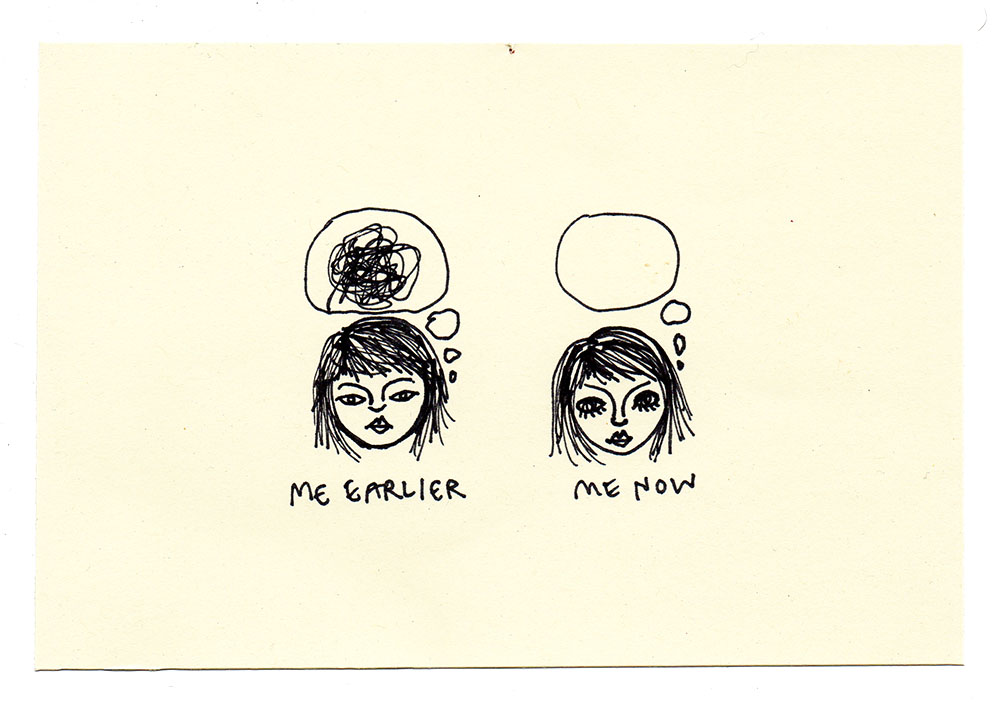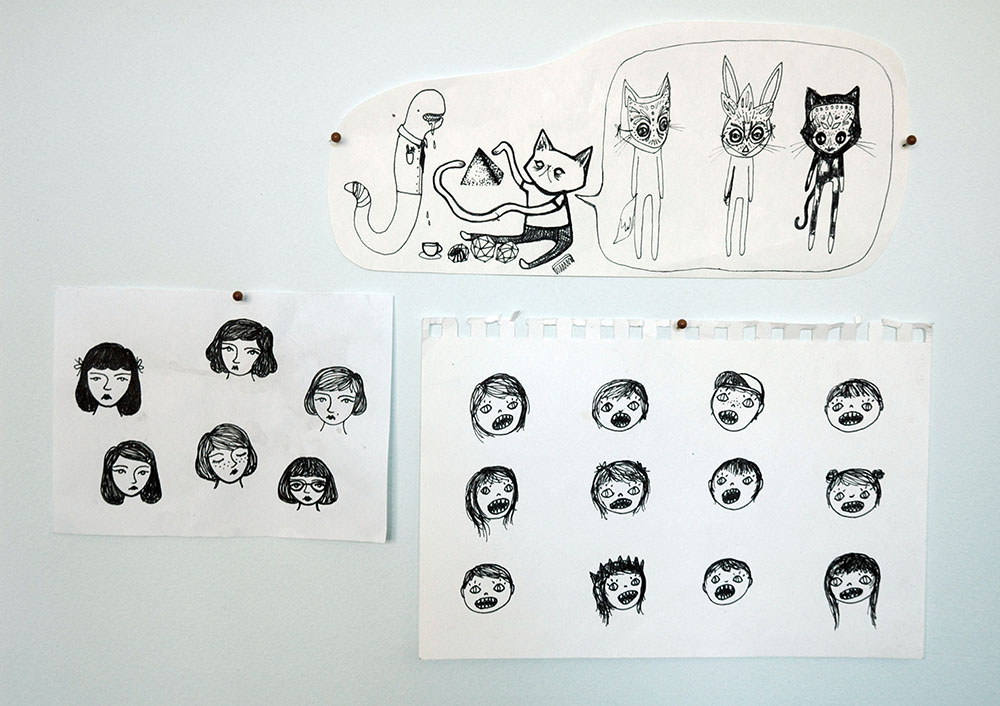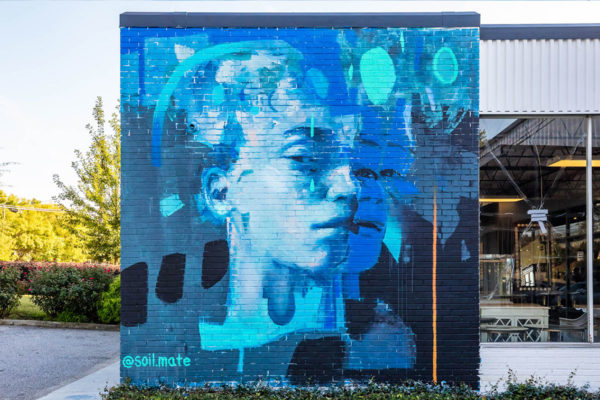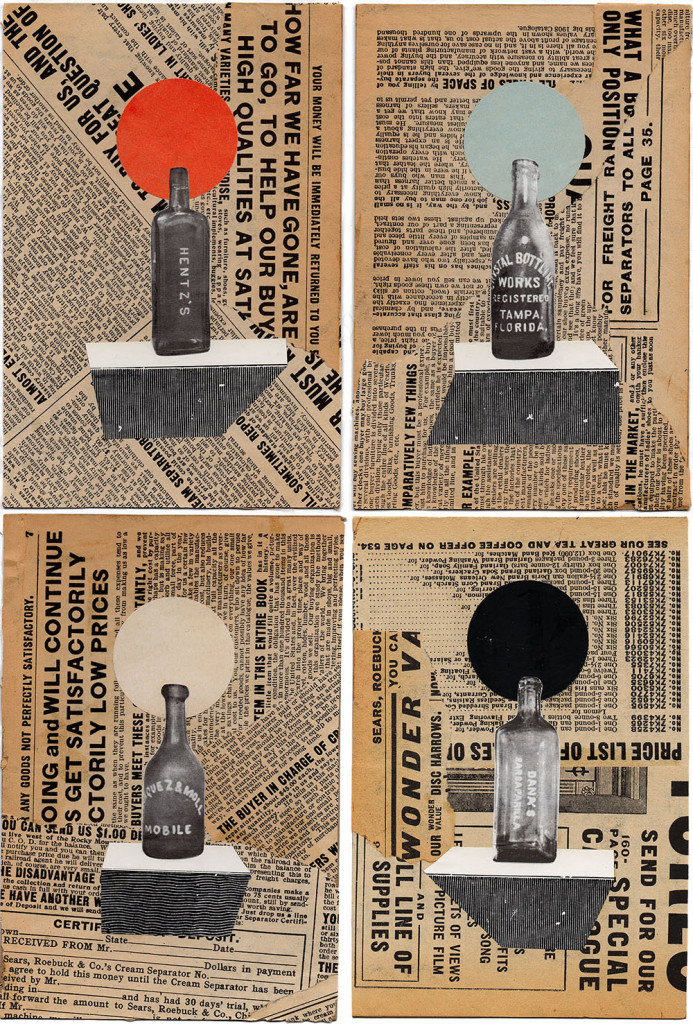 Artist and Atlanta native Madeleine Barreto is drawn to the simplicity of black lines on mixed media. Her illustration work appears on everything from small ceramic pieces and jewelry to handprinted little wallets and collages. What caught my attention when I saw her work at Ladyfest ATL earlier this month were the attitudes of the women in her work: They exude confidence with their poses, looks and whimsical facial expressions. As an illustrator, she’s managed to combine her love of drawing with handmade functional pieces under her year-old shop, Maddy Barreto.
Artist and Atlanta native Madeleine Barreto is drawn to the simplicity of black lines on mixed media. Her illustration work appears on everything from small ceramic pieces and jewelry to handprinted little wallets and collages. What caught my attention when I saw her work at Ladyfest ATL earlier this month were the attitudes of the women in her work: They exude confidence with their poses, looks and whimsical facial expressions. As an illustrator, she’s managed to combine her love of drawing with handmade functional pieces under her year-old shop, Maddy Barreto.
Here, CommonCreativ talks to Barreto about communicating through her art, what inspires her, some of her dream collaborations and what’s next.
CommonCreativ: How did you find your path as an illustrator?
Madeleine Barreto: I’ve been drawing for as long as I can remember. My parents are both creative and my mom started making art with me when I was 2 or 3. It just stuck with me. It has always been a useful tool for communicating things I’m feeling or abstract ideas going through my head. I just need to be making things all the time—that’s the way it’s always been. Something in me requires it. Drawing is how I work things out, record memories, put feelings down and move on from them. I can say so many more things with an illustration than I can try to express with words.
CC: Do you have a day job or do you do SCOUTWARES full-time?
MB: I have a day job as a nanny. It’s pretty perfect because it gives me a lot of free time to work on projects, and the parents are super accommodating and supportive of my small business. I don’t have to do the same thing every day either, which is something that’s important to me. I need to be doing different things to feel good. We have a lot of fun going to the zoo and places like that. Plus, kids love doing art projects and drawing, so they make it easy to get creative all the time. Ultimately, the goal is to be running my own handmade business full-time, but until I can get to that point, I am happy with where I am.
CC: Your ladies have so much swag—how did you find your style and subject matter?
MB: Ha—I guess I have never really thought about that. My style is my interpretation of things I admire. I have themes or archetypes that I stick to, intentionally or not, which end up giving my work a cohesive feel. Animals are important to me so they pop up in my work a lot. Lately, bats have been a prominent symbol in my life. Girls are also a major reoccurring subject. Probably because I am female so it’s the most familiar thing I can put out. There are certain motifs I’m attracted to that I use a lot, some of which come from my childhood.
As my skills develop, my style sort of grows up. Things I’m drawing or making might be the same as past versions in principle, but they start looking different as I push to learn new things. The girls I draw used to be more crazy and cartoonish, and now I’ve put more effort into portraying things and people more realistically—that’s why the girls I draw now look different. I haven’t really thought about portraying facial expressions that much, so that’s probably why they all look so serious. Or maybe it’s a sassy aspect of my personality coming through. Even when I try different techniques or materials, my inner self comes through and things end up coming out in a way that’s just very… me.
CC: What do you use primarily for your drawings?
MB: I usually go for an extra fine sharpie or any other black felt tip pen. I like the simplicity of black lines. When I’m drawing with the kids, it’s a little different. I usually use lots of color, and I think this is the only instance where I do. It’s a good exercise to try something I wouldn’t normally do.
CC: Aside from paper, you print on textiles and work in ceramics. How did you find yourself trying new media?
MB: Being self-sustainable is really important to me, so a lot of what I make comes out of that principle. I like knowing how to make things I need or want, instead of having to go to the store and get it or have someone else make it for me. If there’s something I’d like, I try to make it. The process interests me, and having a finished product that came from hard work is rewarding. I make it my goal to learn as many creative trades/skills as possible. Functional objects and design are what interest me the most, so the things I make usually fall into those categories.
It’s good to have different outlets though. I am very meticulous and like to do things the right way, so a lot of the time I’ll get hung up in the detail of something I’m working on or draw out the process. With things like paper collage, I can have the satisfaction of putting something out without having to work too hard on it, because there’s no right or wrong way to do it. Ceramics are good for that too. It’s easy to transform an object into something else if it’s not going as planned. Block printing is a good challenge on the opposite hand because there is really no room for error. It’s important for me to push myself to try new media so I don’t get tired of what I’m making, and to give myself room to grow as an artist.
CC: What’s your creative process? How do you get started?
MB: I am a big list maker so I usually have a roster of things I would like to make (or ideas that have been going through my head) at all times. When I feel the need to make something but I’m not really sure what, I’ll refer to that list and try to pick one of the projects. For things like stamp-carving, or when I’m making functional objects, I start with an initial sketch, then I just go for it. With ceramics, sometimes I’ll have an idea of what I want to make, and other times I just go into it as sort of a meditation. When I start a collage, I have no preconceived concept of what it will look like. I’ll go through old books or magazines and start gathering elements I like, and the piece just comes together through that. The end result still captures how I was feeling during that time, which is interesting to me, but not surprising. It’s kind of like the visual version of automatic writing.
MB: Animals, the moon, nature treasures, getting organized and having a clean workspace. I usually find myself most inspired looking at books. I have a few that always get me really excited about making art like this symbol sourcebook, and some old tattoo flash books. I also recently gifted myself a Marcel Dzama book that has a ton of great paintings in it. Being around other people who make art and are creative is also incredibly vital to me and my creativity. Maybe just being around people in general is what inspires me. I guess I kind of feed off their energy. Also, re-watching Beautiful Losers always gives me a drive to create.
CC: What are some of your favorite artists in Atlanta?
MB: Ronnie (R. Land), Sam Parker, Trek Matthews, Brandon Sadler, and Ashley Anderson. I got a copper etching print from Joe Tsambiras at Atlanta Zine Fest last summer that is really wonderful.
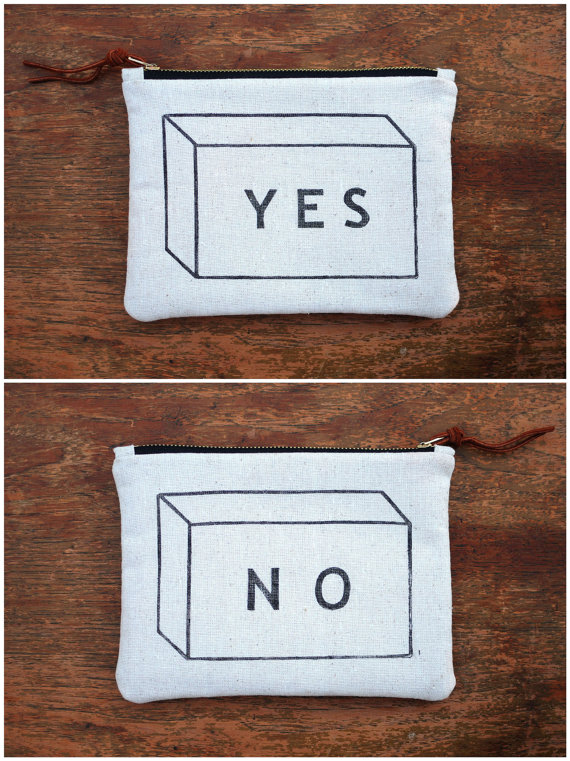 CC: What’s your favorite place to hang out in Atlanta?
CC: What’s your favorite place to hang out in Atlanta?
MB: Hodgepodge is a good place to go sit and read or work on things. I am a homebody so usually I like to stay in with my animals, mainly because I like to be working on things in my free time. Once I get started it is difficult to get myself out of the house. Ceramics have been a good reason for me to get out though. I work in the studio at Wonderroot, so I’ve been spending a lot of time there. If I had a ceramics studio at my house, no one would be able to find me.
CC: What would be your dream collaboration?
MB: Probably Yoshitomo Nara. I think his sassy girl characters and mine are kindred spirits. Stacey Rozich is another artist I really admire. She does incredible watercolor paintings, and her characters usually have animal heads and wear these beautiful intricate textiles. Kaye Blegvad makes really great illustrations that always resonate with me. Gustav Klimt would be my #1 though, if he was still alive.
CC: What are your thoughts on Atlanta’s creative scene?
MB: There are always things going on, which is really great. I don’t even have to usually look for markets to participate in because people are always spreading the word or inviting me to be involved, which I feel very grateful for. The creative/maker scene feels very warm here. Most everyone I meet is good hearted, and I have made many friends who are dear to me. People are excited about each others’ art instead of being competitive in a negative way, which is how it should be.
CC: What’s next for SCOUT?
MB: I have been more into making ceramics than anything else lately, so I can see myself heading further in that direction. I also just started taking a jewelry metalsmith class so hopefully some exciting things will come out of that. Getting my products in more stores is one of the top things on my to-do list for SCOUT.
You can see more of Madeleine’s work in her Etsy store and Tumblr.

